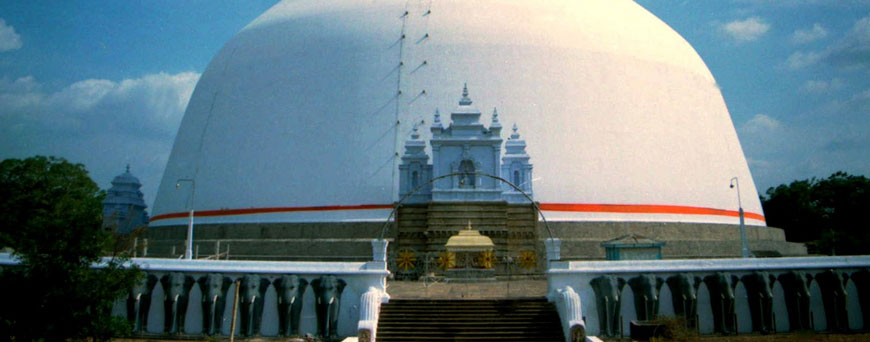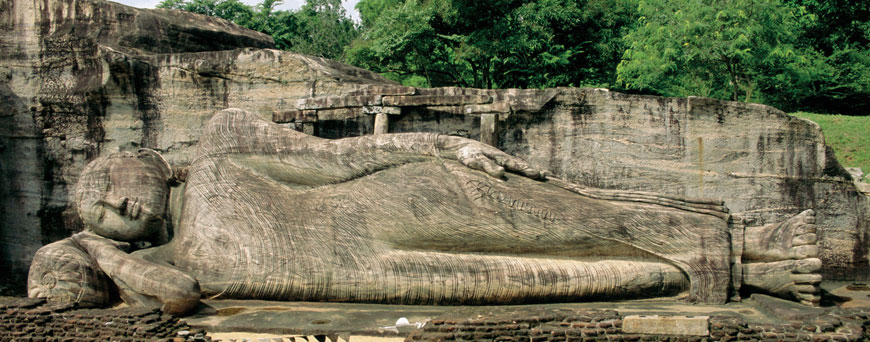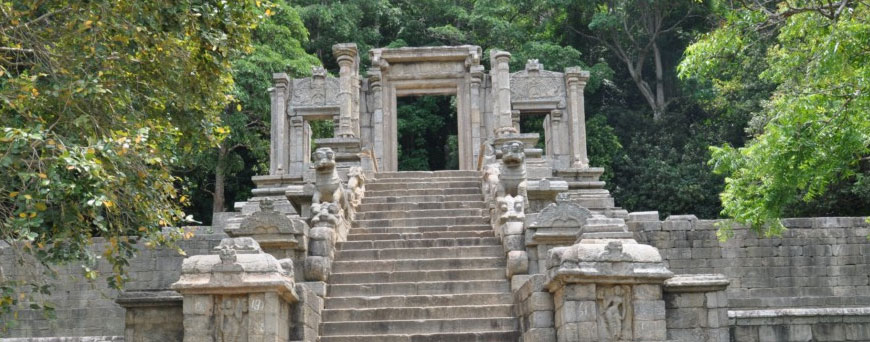

Anuradhapura
Anuradhapura is the first capital of Sri Lanka then called Ceylon and is well known for historical monuments and splendid architectural specimens. Some of the interesting tourist places to visit are the 'Samadhi' Buddha Statue inaugurating in deep meditation, holy Bo Tree under which Buddha attained enlightenment 2500 years ago, monasteries and Ruwanveli Seya.
Isurumuniya Rock Temple is also a famous attraction as it shows the splendid rock carving of the 3rd Century B.C.
The Anuradhapura Kingdom lasted one thousand and five hundred years from 380BC. This city is home to many of the early grand monuments of Sri Lanka. Anuradhapura is also a popular destination of Sinhalese Buddhist pilgrimages due to its many ancient Buddhist monuments.
Anuradhapura has been made the royal capital by King Pandukabhaya in 380 BC. It remained a residence and royal capital for 119 successive Singhalese kings till the year 1000 AD when it was abandoned and the capital moved to Polonnaruwa. You will see some of the most famous as well as the tallest dagobas of Sri Lanka, remains from palaces, temples, monasteries, ceremonial baths and the temple of the holy Bo-tree. This tree was grown from a sapling of the very tree under which the Buddha attained enlightenment more than 2500 years ago.

Polonnaruwa
Polonnaruwa was the second capital city of Srilanka. The city was built during 11th and 12th Centuries AD and today it is one of the best preserved cities in Srilanka with interesting places to see are ruins of the Royal Palace, The Gal Viharaya where wonderful statues of Buddha with Upright, Sedentary and Viharaya postures can bee seen.
Polonnaruwa, which became the capital of Sri Lanka following the decline of Anuradhapura, was to witness the Sinhalese Buddhist civilization reaching still greater heights The vast irrigation network with reservoirs that look like natural in-land seas sustained such epic scales in rice cultivation,
during the reign of king Parakramabahu the Great (1153-1186 A D), Sri Lanka became known as the Granary of the Orient Among the main tourist attractions at Polonnaruwa are preserved ruins of magnificent royal palaces,
enormous Buddhist temples, intact monumental sculpture in colossal statues carved from sold rock boulders that once rivaled Anuradhapura in magnificence Today, Polonnaruwa,
a UNESCO World Heritage Site, with its preserved ruins and restored ancient irrigation reservoirs is a “must visit” cultural destination of Sri Lanka Holidays As much as the preserved cultural monuments would enlighten the tourists,
the wild life sanctuaries in the district of Polonnaruwa affords ample opportunities for the joy and fun in the close range of wild elephants, other mammals to the lovers of wildlife At the city of Polonnaruwa itself is the largest ancient irrigation reservoir called Parakrama Samudra (Sinhala: the Sea of Parakrama) is always lovely,
and with the plethora of birdlife, it is seldom that there is not something interesting going on upon its shimmering expanses of waters No rest house in Sri Lanka Holidays has a lovelier waterscape than that of Polonnaruwa Rest House nestled at the end of the immense motorable bund of the magnificent reservoir under the shade of mighty trees.

Galle fort
The Galle fort is a world heritage site and the largest remaining fortress in Asia built by European occupiers.The most enjoyable way to experience the Galle Fort is by walking.
A leisurely walk leads past the old Dutch Church, the Governor’s house, the spice warehouses, Court Square, the Kacheri (town hall), the lighthouse and on to the sea wall and ramparts. Visit the mosque and meander down streets leading to cricket fields, the temple, and the old District Judge’s house surrounded by ancient frangipani trees.
Galle is the best example of a fortified city built by Europeans in south and southeast Asia, showing the interaction between European architectural styles and south Asian traditions. The Galle fort is a world heritage site and the largest remaining fortress in Asia built by European occupiers.
Other prominent landmarks in Galle include the natural harbor, theNational Maritime Museum, St. Mary's Cathedral founded by Jesuit priests, one of the main Shiva temples on the island, and Amangalla the historic luxury hotel.
According to James Emerson Tennent, Galle was the ancient seaport of Tarshish, from which King Solomon drew ivory, peacocks and other valuables.
Cinnamon was exported from Sri Lanka as early as 1400 BC and the root of the word itself is Hebrew, so Galle may have been a main enter port for the spice. Galle had been a prominent seaport long before western rule in the country.
Persians, Arabs, Greeks, Romans, Malays, Indians, and Chinese were doing business through Galle port. In 1411, the Galle Trilingual Inscription, astone tablet inscription in three languages, Chinese, Tamil and Persian, was erected in Galle to commemorate the second visit to Sri Lanka by the Chinese admiral Zheng He.
The "modern" history of Galle starts in 1505, when the first Portuguese ship, under Lourenço de Almeida was driven there by a storm. However, the people of the city refused to let the Portuguese enter it, so the Portuguese took it by force.
In 1640, the Portuguese had to surrender to the Dutch East India Company. The Dutch built the present Fort in the year 1663. They built a fortified wall, using solid granite, and built three bastions, known as "Sun", "Moon" and "Star". After the British took over the country from the Dutch in the year 1796, they preserved the Fort unchanged, and used it as the administrative centre of Galle.

Yapahuwa
Yapahuwa was one of the ephemeral capitals of medieval Sri Lanka. The citadel of Yapahuwa lying midway between Kurunagala and Anuradhapura was built around a huge granite rock rising abruptly almost a hundred meters above the surrounding lowlands.
In 1272, King Bhuvenakabahu transferred the capital from Polonnaruwa to Yapahuwa in the face of Dravidian invasions from South India, bringing the Sacred Tooth Relic with him. Following the death of King Bhuvenakabahu in 1284, the Pandyans of South India invaded Sri Lanka once again, and succeeded in capturing Sacred Tooth Relic. Following its capture, Yapahuwa was largely abandoned and inhabited by Buddhist monks and religious ascetics.
The Tooth Relic was brought from Dambadeniya and kept in the Tooth Temple built for the purpose at the top of the third staircase. The relics were carried away from the temple here to South India by the Pandyas, and then recovered in 1288 by Parakkramabahu III (1287–1293), who temporarily placed them in safety at Polonnaruwa.
Yapahuwa was one of the ephemeral capitals of medieval Sri Lanka. The citadel of Yapahuwa lying midway between Anuradhapura and Kurunegala was built around a huge granite rock rising abruptly almost a hundred meters above the surrounding lowlands.






